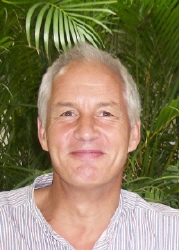| | First Inpatient Fellowship for Licensed Acupuncturists Under Way at New York's Beth Israel Hospital | |
Summary: The nation's first inpatient fellowship for licensed acupuncture is into its second year in the Department of Integrative Medicine at New York's Beth Israel Hospital. The year-long fellowship is under the direction of Arya Nielsen, PhD, LAc and Ben Kligler, MD, MPH. The program consists of clinical service for a wide range of conditions and environments, plus didactic and often grand-rounds style instruction, much of which is paired with an integrative medicine program for the hospital's medical doctors. Here is an overview of the program, with details on its financial model.
 Arya Nielsen, PhD, LAc; Fellowship director
Materials on the fellowship state that "the
goal of the program is to integrate acupuncture into inpatient care across
hospital specialties while creating an opportunity for licensed
acupuncturists
to work in a hospital setting." Fellows will also "interact across disciplines in research development to clarify
the role
of acupuncture in hospital-based care."
______________________________
New York's Beth Israel Acupuncture Fellowship:
At a Glance
| |
|
|
| Founding |
|
September 2008
|
Sponsor
|
|
Department of Integrative Medicine,
New York Beth Israel Hospital
|
Co-Directors
|
|
Arya Nielson, PhD, LAc;
Benjamin Kligler, MD, MPH
|
Linked program
|
|
Physician Fellowship in Integrative Medicine,
directed by Kligler
|
Total Fellows to date
|
|
20
|
Typical group size
|
|
6-8
|
Prerequisites
|
|
License to practice; some clinical experience;
interest in integrative medicine; interest
in research
|
Duration of program
|
|
1 year (50 weeks)
|
Clinical care shifts
|
|
Minimum of 2 4-hour shifts per week;
roughly 400 hours total
|
Didactic education
|
|
3 hours week (2 with MD integrative
medicine residents; 1 additional);
roughly 150 total
|
Department served
|
|
Surgery, Orthopedic Surgery, Family
Medicine, Internal Medicine, Oncology,
Pain and Palliative Care, Cardiac Step-down,
Pulmonary Rehab, OB
|
Research component
|
|
2 projects under way; focus on research
literacy and command of evidence in
focused areas; proposal writing to IRB
standard
|
Cost of fellowship
|
|
$3600
|
Contact for Nielsen
|
|
anielsen@chpnet.org; 646-935-2231 |
| |
|
|
______________________________
The hospital's department of integrative medicine, directed by Woodson Merrell, MD, was founded in 2006 as one of the first inpatient-outpatient integrative programs in the country. (See
this November
22, 2006 Integrator article.) Beth Israel Medical Center is part of multi-hospital Continuum Health Partners. The outpatient hub for the integrative practice effort is the Continuum Center for Health and Healing, one of the nation's most significant integrative medicine centers.
 Host: New York's Beth Israel Hospital
An additional value for participants in the program is its co-habitation with the department's Physician Faculty
Fellowship program in Integrative Medicine, directed by Benjamin Kligler, MD, MPH, one of the nation's foremost educators in his field. Kligler co-authored a paper on competencies in integrative medicine which was endorsed by the Consortium of Academic Health Centers for Integrative Medicine, for which Kligler presently serves as vice chair. For typically 2 hours each week, acupuncture fellows participate with a group of 6-8 medical doctors in seminar
style
lectures by specialists related to integrative medicine. Says Nielson: "The notion is to create community. (Ben) is happy about this, as I am. This creates a bi-directional sharing." The fellows also have the opportunity to participate in discussion of patient care via on-site
hospital rounds.
Financial model
 No revenues from acupuncture services
She shares that some fellows have wondered that they are not being paid for their work, rather than paying for it. Such a shift would make it more of a residency model. Nielsen says that she "couldn't agree more." However, money is not available as acupuncture services don't generate any income for the hospital says Nielsen. In fact, her own time she spends as director is only compensated at 1 day
per week.
Nielsen is a firm believer that "this needs to move into something reimbursable, this needs to change." For the present time such efforts are held back by the challenges of making changes in a large hospital system. Establishing the internal data processes and
personnel practices to support billing has thus far presented challenges that seem
insurmountable.
Comment: This fellowship is an exciting model and opportunity, though clearly most appealing to a licensed acupuncturist in the New York City area. Cohabiting with the integrative medicine program Kligler directs clearly adds additional value.
Yet this is a thumbs up, thumbs down scenario. While the hospital and department deserve kudos for piloting this program, the economics remain a distasteful display of second class citizenship. Let's say Nielsen has 6 of these residents. Each provides clinical services for 8 hours a week. That's 48 hours of free labor. Meantime, Nielsen has a high level of volunteerism in her own work.
Bottom-line: One would hope that the hospital could value the fellowship with a subsidy which reflects at least the cost of a full-time acupuncturist. Let's see: If each of the 48 hours reflected only one treatment, that would be 2400 treatments in 50 weeks. If each visit was reimbursed (or valued by the administration as an add-on benefit the hospital provides and can advertise for providing) at just $25, the program would be "worth" $60,000. At $40, $96,000. And at $40 per treatment and 2 treatments per hour, the value to the hospital is approaching $200,000.
As Nielsen pointed out in her Integrator interview, something needs to change. Meantime, it is good to see these opportunities opening.
| Resumes are useful in employment decisions. I provide this background so that you may understand what informs the work which you may employ in your own. I have been involved as an organizer-writer in the emerging fields......more |  |
|
|
|
Popular & Related Products
Popular & Featured Events
Dimensions of Wellness
|
|